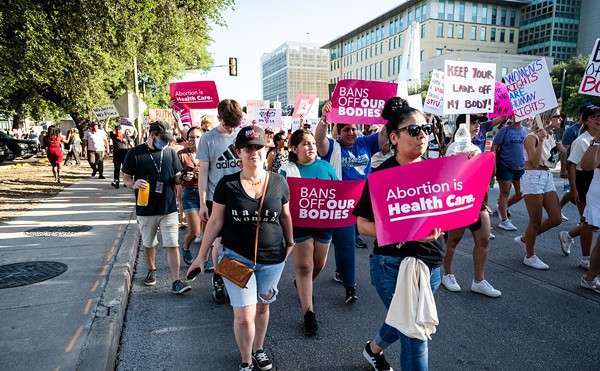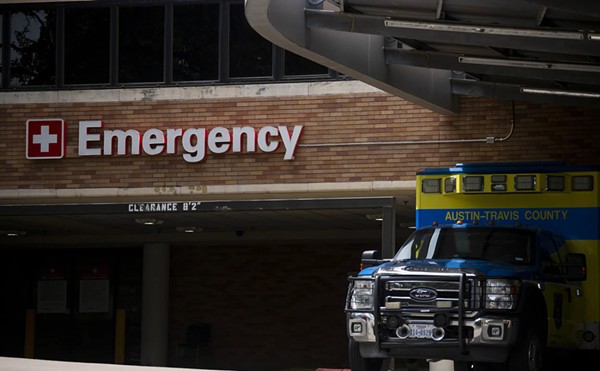For $5,000, infertile couples can select two frozen, ready-to-order embryos that will produce babies with the exact hair and eye color and other physical traits that potential parents desire for their future children.
Critics may call it eugenics, but Jennalee Ryan, founder of the Abraham Center of Life in San Antonio, says the time for an evolution in human reproduction is now.
Advertising itself online as the "World's First Donor-Created Human Embryo Bank," the Abraham Center has created new options in in-vitro fertilization for infertile couples seeking an alternative to mainstream medical conception.
REPRODUCTION PART 1: WHEN A BOY AND A GIRL LOVE EACH OTHER VERY MUCH ...
Human reproduction is a deceptively complex process. The most opportune time for fertilization to take place is when a woman's ovary releases a mature egg during ovulation. From there, the egg enters one of two fallopian tubes and waits for the male gamete to reach its destination.
During intercourse, a man releases semen at the base of a woman's uterus, which (and we know we sound like a '60s health-doc when we say this) begins the sperm's long journey. After crossing the cervix, the sperm, which must complete the fertilization process in its short 12 to 48-hour lifespan, travels up the uterus to the fallopian tubes where it must penetrate the egg's cell membrane to fertilize it.
The fertilized egg divides when the pronucleus of the egg merges with the sperm's nucleus. From there, the fertilized ova is pushed along the fallopian tube to the uterine lining where it rests for about two days. The sixth day after fertilization, the ova implants itself in the uterine wall and pregnancy officially begins.
REPRODUCTION PART 2: WHEN A SPECIMEN AND A SPECIMEN MEET ...
In a traditional IVF procedure, several ova are removed from a woman's body and injected with sperm from the father (substitute an egg donor and/or sperm donor where needed). Once fertilized, up to four embryos can be implanted inside the uterus of the mother or surrogate mother. The remaining embryos are cryogenically frozen and kept in fertility clinics until their fates are decided. Extra embryos may be discarded, or used for embryonic-stem-cell research, two options that critics who consider an embryo a human life view as immoral. The embryos could also be saved for the couple, in case the first IVF cycle is not successful, or in case they opt for more children in the future. Lastly, the couple or parent may donate the embryos to other women.
"Now there is a much better way to have a child, and that is what I am doing," said Ryan, 48, as she sat in the living room of her lavish home in the upscale Dominion community on the North Side of San Antonio.
"I saw a demand for something and created the product."
GRADE A EGGS
According to the National Embryo Donation Center, there are approximately 400,000 frozen embryos in fertility centers across the nation - a limited supply when you consider there are more than 6 million infertile couples in America, according to the American Society for Reproductive Medicine. Through the Abraham Center, Ryan, a mother of six (three were adopted and three still live at home), created a procedure to mass-produce embryos from the same mother and father. To do this, Ryan contracts an egg donor who is willing to go through the IVF procedures; meanwhile, she purchases sperm from an online sperm bank. So far, 23 embryos have been created for the Abraham Center, and 10 women have been implanted with two embryos each.
Critics call it "made-to-order embryos" or "designer babies." The procedure is controversial because it seeks to engineer human heredity traits in hopes of improving the overall human gene pool in terms of health, intelligence, and physical appearance - but isn't that already Nature's job? (And unlike Ryan, Nature does that for free, weeding out the weak and handing out Darwin Awards to the clumsy in her wake.)
Then there are those, like the Daily Mail, who condemn Abraham Life's practices as a pseudoscientific method that imposes genocide on specific races, an argument the fellas at the Reason Institute think tank call "the conventional Aryan baby/implied Nazi eugenics polemic." And Ryan's service is in a harsh spotlight, of course, from pro-lifers who question whether an embryo is a human life already, and if selling them is the equivalent of selling children on the black market.
Ryan says her procedure is just much more practical than more-common fertility options - especially when you consider cost, which, at $5,000 for two embryos is much less than traditional IVF or adoption, which can cost up to $12,000 and $30,000 respectively, or more.
Other differences between Ryan's business and traditional IVF is that she only uses "proven" egg and sperm donors - the sperm and egg donors do not have a history of infertility.
"Most of these other available embryos have been created from the biological matter of infertile couples," said Ryan. "So the rate of quality as a whole is lessened versus those that have been created using both a proven egg and sperm donor."
The success rate for pregnancies with an egg from a woman who does not have a history of infertility is about 70 percent, while implanting a leftover frozen embryo the traditional IVF way brings closer to 30 percent success, according to ASRM.
"Millions of people can't have children, and now, through science, we can allow them to have what they once could not," Ryan said. "I know that there is a need and I've created something to fulfill that need even though it's still in the - excuse the pun - embryonic stages."
Ryan notes the fertilization problems organizations like Nightlight Christian Adoptions have with their Snowflakes Frozen Embryo Adoption program: Since its inception in 1997, Snowflakes's sole purpose has been to connect infertile families to some of the thousands of unused embryos currently sitting in clinic freezers.
"Although there are 400,000 frozen embryos, they're not available. They are just going to sit there until they are no longer usable," she said. In the last nine years, Snowflakes has seen only 116 births through its program. However, Dr. William B. Hurlbut, consulting professor at the Neuroscience Institute at Stanford University says that 98 percent of the 400,000 embryos currently frozen are preserved by the family with the hope of being implanted at a later date, which is why a program like Snowflakes has not flourished as first anticipated.
Ryan says that's also because a recipient family is arguably "adopting" the embryo. An agency like Snowflakes must conduct an at-home analysis - similar to one that would be performed during an adoption process with the recipent couple to make sure the potential child will be raised in a suitable environment. According to Snowflakes Southern Regional Director Natasha Nechiporenko, post-placement supervision is mandatory for the recipent family six weeks after the child is born. This "required screening process," Nechiporenko says, includes a visit from a social worker and a contractual agreement between the recipent family and Snowflakes to provide a monthly report and pictures of the child to the organization.
"This can sometimes add insult to injury to an infertile family, who has had to bear so much already in the process, and now must prove that they will be good parents," Ryan said. "Some desperate people will do it, but isn't there a better way?"
After fertilization, Abraham Life implants all of the embryos created, claims Ryan; none will be frozen long-term for future use.
"There will never be extra ones," Ryan said, adding that all embryos that will be created in a planned second cycle for November are already reserved. "As I do this, I have lists of people waiting for them. I have more people wanting them than I have embryos." Ryan says that all the embryos are spoken for, but there is no way to verify her claims because she will not provide the Current with a client list. Ryan did verify through a three-way phone call that what she is saying has also been told to at least two other people - one potential client (not currently promised embryos) and the lone egg donor for the second cycle.
Dr. Steven Ory, president of the the American Society for Reproductive Medicine, believes Ryan's procedures flout some ethical and moral guidelines. The Abraham Center, he says, is a "very repugnant idea that represents the ultimate nightmare people in the bioethics field have."
What's more, he questions just how many babies will come from Ryan's matchmaking business. It is a biologic fact that a number of embryos during any cycle will be lost in the process, he says.
"I think for a couple being promised a couple of embryos there would be nowhere near the 70-percent success rate `Ryan` is saying," Ory said. He adds that a substantial number of the embryos would carry a chromosomal anomaly that would cause them to stop developing soon after the implantation.
"If `Ryan` is dividing up the available embryos, then a significant number of those couples are going to end up empty-handed," Ory said.
Despite the ethical and scientific questions, there is no regulation entity that oversees fertility clinics and their practices in the U.S. Unlike the U.K.'s Human Fertilization and Embryology Authority, which licenses fertility clinics and all research on human embryos, the U.S. has very limited guidelines.
MATCHMAKER, MATCHMAKER ...
Ryan is not a scientist.
A native of San Fernando, California, she left an abusive home at the age of 15 and settled into real estate at 19. "I didn't come from a good background," Ryan said. "During my childhood, I'd look over at another car with 'normal' people in it and wish they would pull us over and take me away. The truth is, the more you struggle and fight, the bigger and stronger you become."
Because of the mixed experiences she had as a single mother who adopted children, she decided to form her own adoption agency - Silver Spoon Adoptions - in 1991. It currently shares a phone line with the Abraham Center.
"As a businesswoman, and as someone who deals with people every day that can't have children, I wanted to offer another service," Ryan said. "I wanted to find the next mountain to climb."
As advances in reproductive technology became more readily available, Ryan kept an eye on medical breakthroughs like IVF, artificial insemination, and human cloning. And after moving to Kerrville, Texas in 2004 and then to San Antonio last year, Ryan began her enterprise here when she advertised for and was contacted by a number of egg donors. Choosing one that best met her clients' requests (most infertile couples she works with are seeking Caucasian babies), she searched for a sperm donor online and selected an individual with the physical characteristics families have asked for.
She claims that all the sperm donors she selects have Ph.Ds - at least, that's what her sperm supplier, Fairfax Cryobank, says it offers. Customers like Ryan get their pick of ethnicity, blood type, height, and hair and eye color. For an extra cost, buyers can see childhood photos and sometimes adult photos of the donor. The cryobank also provides "staff impressions" from employees who were able to get a glimpse of the sperm donor during his visit to the clinic. For Donor No. 2529, the staff impression reads, "This donor has the all-American look, with an exceptional physique. At 6'2", hazel eyes, and blond hair, he has a surfer-boy style. He is shy and quiet with our staff. He is also bright with a laid-back attitude."
"They make it easy for me to choose," Ryan said. For the first couple, she says, she chose as donors a blond-haired, blue-eyed, Caucasian male and a brown-haired, hazel-eyed, Caucasian woman.
"This is the problem that people have; because I am playing God by being the one that has to decide which donors to put together to create an embryo," Ryan says.
In June 2006, Ryan's first batch of eggs and sperm were sent to a clinic in Houston, where a fertility specialist, who did not know what the donations were being used for, created 23 embryos. When the Houston doctor she was working with found out how the embryos were being used, she dropped out of the project.
"She kind of freaked out," Ryan said. "But if they are my embryos, legally, what I do with those embryos is really none of her business."
Ryan says she is now working with a fertility clinic in New York. She would not, however, divulge information about the current clinic, nor would she name the Houston-based doctor who dropped out of the project after the first cycle. After a number of inquiries to approximately 10 fertility clinics across the U.S., the Current was unable to find a doctor willing to do what Ryan says her New York fertility doctor is doing for her. All doctors that the Current spoke with said it would be difficult to find any doctor eager to follow through with Ryan's procedure. However, most of them also said there are less-than-reputable fertility clinics out there that would probably do anything for a price.
To date, Ryan says, two women - one from California and the other from Canada - are pregnant and are expected to deliver sometime in March 2007. She says the rest of the embryos are waiting to be implanted. All the embryo recipents for the second cycle have been selected, as have both the egg and sperm donors - a brown-haired, green-eyed Caucasian male and a blonde-haired, blue-eyed, Caucasian female. Ryan dismisses the idea that the ethnicities of donors are a factor and that she is only willing to create Caucasian babies.
"People are saying, 'Well, you're only creating blond-haired, blue-eyed embryos,'" Ryan said, an idea she refutes by pointing out that her own adopted children are African-American and Hispanic. "They want to make this a Nazi thing. Although people might think this, I am not the next Hitler. My focus is not on creating the next Aryan race. It's absurd to think that I am creating a Nazi regime. There is simply a demand for white babies."
For Matthew Eppinette, assistant director of the Center for Bioethics and Human Dignity in Bannockburn, Illinois, it does not matter to him who is donating or receiving the embryos. All who are involved are assisting in the degradation of human life.
"`Children` are not a project that you put this kind of work into and aim for a particular result; they are gifts to be nurtured, cherished, and loved," Eppinette said. "What reproductive technology has come to is unfortunate, but also a logical conclusion, living in a consumerist-driven society the way that we do. This technology coming together with the consumer's desire is what inevitably leads to something like this."
Stanford's Dr. Hurlbut says Ryan is opening the door to greater genetic profiling and catastrophic consequences down the road.
"We are getting farther and farther away from the natural biological process," Hurlbut said. "It seems like we are turning procreation into manufacturing and taking control of things that we shouldn't be. These embryos are really self-generated tragedies."
Still, the future Ryan imagines is one where all infertile families use a procedure like hers to have the children of their choosing.
"It's going to evolve wherever it's going to evolve, and I don't see an end to it."
| 4 Phrases on Embryos Know how when you’re abroad you can convince a Mexican policeman, after he’s dragged you off a public bus, that you’re not a major drug dealer, or talk some Chinese farmers out of getting you drunk beyond your limits, and all you need are a few useful phrases (like “Why do you have ice and I don’t?” in Portuguese, “Por que você tem o gelo e eu não)?” Well, here are some cold, brisk lines that you can use domestically. It’s “4 Phrases On: Embryos” 1. John-Henry Westen at the online news agency LifeSite.net, said he and his fellow pro-lifers say “even with one cell … an embryonic child is a child, just smaller and younger,” and they shouldn’t be sold. (LifeSite reports that Abraham Center of Life’s director Jennalee Ryan “responded to religious objections saying, ‘Jesus was not conceived in the normal way either.’”) 2. President Bush finally pushed the big bill-killing button after almost six years as Banana in Chief, when in July he vetoed an embryonic-stem-cell-research bill that would’ve loosened the federal purse to support degenerative-disease and spinal-injury research. (Bush called the “fetal farming” an immoral taking of an innocent human life; ironically, the newspapers that day said 14,338 Iraqi civilians had been killed from January to June.) 3. Attention infertile consumers (and the people who care for them): Embryo labs must report their babymaking-success rates to the U.S. Centers for Disease Control, thanks to the Fertility Clinic Success Rate and Certification Act of 1992 … so shop around! 4. In 2001, the Brits became the first country to explicitly allow the creation of embryos to cultivate stem cells; soon after they were cloning human embryos, and laying down bricks and mortar for an independent outfit, the Human Fertilisation (notice the effete British spelling) and Embryology Authority, to regulate all U.K.-based treatment and research involving embryos. (The Guardian reports that British scientists, obviously Wallace & Gromit fans, sought approval earlier this year to create hybrid embryos by fusing human cells with rabbit eggs.) —Keli Dailey |


















